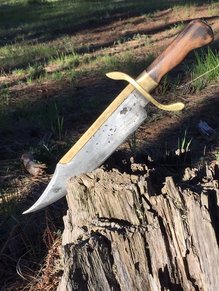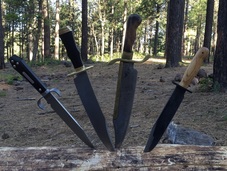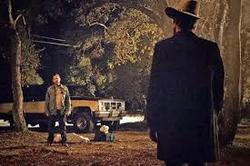
Firstly is the largest of the group, a semi-custom by Plowshare Forge. I say “semi-custom” because it’s a standard catalog item for the maker, but it’s also a handmade item that isn’t made until you order it, and you can make specific requests, so in that respect it’s custom. Plowshare Forge specializes in the rough and tumble world of “frontier” blades, blades that recreate the knives that our cowboys, or our doughboys and GIs would have had made for them by local smiths and actually carried into battle. No high polish sheen here; these are hard core working blades, and he intends them to look the part.
This knife is a Musso Bowie, so named because the original upon which this is based was owned by a Joseph Musso. He claimed this knife was THE knife owned by Bowie himself, which nearly all scholars dispute, but it’s still a super cool knife, which, in the world of Bowie knives, counts for at least as much as historical authenticity. As they say in The Man Who Shot Liberty Valance, “when the legend becomes fact, print the legend.” The Musso bowie is almost certainly not the blade that James Bowie actually carried in his famous Sandbar Duel . . . but it’s what he should have had.
For those of you keeping score, this is the knife Emmett carries in my novel The Ballad of the Laurie Swain. It’s big and bold, just like Emmett himself. The blade is nearly 13 inches long, and almost 3 inches wide. It has a large “S” guard and a strip of brass which runs almost the full length of the spine of the blade. This brass strip has been the subject of some discussion in Bowie circles; I originally heard that it was supposed to be for parrying in knife dueling, with the idea that the soft brass would “catch” the opponent’s blade and open him up to a counter attack. I don’t buy the “blade catcher” story, but I do think the brass strip is designed for parrying; the softer brass would absorb the shock of the blow and protect the more brittle (and more expensive) steel beneath. Higher end knives often have a differential temper, in which the spine is softer than the edge, to accomplish the same thing, but that’s an awful lot to expect of a frontier blacksmith.
Do you remember the Bowie quote about what his knife should do? Sharp enough to shave, broad enough to use as a paddle, heavy enough to chop like an ax, long enough to cut like a sword . . . when one thinks of all those requirements, this knife embodies it all.
This blade is impressive. It’s large and feels heavy. The blade is not unduly thick, but the point of balance is far forward, about a solid 3 inches from the crossguard. This balance point makes the knife feel very blade-heavy, and it handles like a saber in the hand. This is neither good nor bad, just an idiosyncrasy of the blade that differentiates it from others. As a woods blade, a frontier knife depended upon to do camp chores (or row a small boat!) such a weight forward balance is an asset - it makes the knife a better chopper for cutting kindling or even making a shelter - this is the chopping like an ax part of Bowie’s famous recipe. As for a fighting knife . . . well, such a forward balance point makes it slower in the hand. Whether or not that would be a liability would depend heavily on what sort of weapon one were facing. If it were a saber, spear or lance, then not so much. If it were a lighter, faster knife, it could be a problem.
One issue I have with the design is the tip. It is SO thin and narrow! In some respects this is perhaps not a problem, and it is certainly an intentional design. The tip has a dramatic upward sweep the terminates in a narrow tip that rises above the center line. Combatively, this is designed to facilitate a back cut, as the top swedge of the blade is sharpened. This is purely a combat feature; not only is not necessary in a field knife, but it could actually be a liability, as it creates an additional edge that can cut the user if one is inattentive. Small, fine woodcraft cutting tasks become more complicated when the upper edge is sharp. Also from a combative perspective, the tip is swept too far up to make an effective thrusting design; the actual tip only works when thrust along an arcing line, as in a back cut. In a straight thrust the point doesn’t pierce as effectively as it could, leaving it to the belly of the blade to cut its way in. It’s certainly capable of a straight thrust, but this would force the knife to work against its own natural edge geometry and it wouldn’t pierce with nearly the efficacy that it could if the tip were positioned differently.
So my beef with this design centers on that narrow, narrow tip. It is, in my opinion, structurally weak. While such a narrow tip ought to be good for thrusting, this one really isn’t because the tip is pointing up and off the center line. And I can’t imagine trusting this skinny tip to hold up under any sort of hard use, especially lateral forces on the tip, whether that force is from prying dead wood from a log for kindling, or getting one’s tip stuck in the ribs of a human adversary (not that this is an issue for me).
For fans, this pattern of knife is offered under the general title “primitive bowie” from places like Atlanta Cutlery and its ilk. More recently, a highly polished version of this knife is featured in the film series The Expendables. It is thrown to great combative effectiveness (don’t even get me started… perhaps I’ll write a separate blog just about throwing knives). Still, this knife represents what a combat blade ought to be to a large percentage of the (probably male) viewership, and it certainly represents the epitome of a large frontier bowie knife.
To get your own:
Plowshare Forge:
http://plowshareforgeknives.blogspot.com/2009/07/musso-bowie.html
Expendables Bowie:
http://www.budk.com/Gil-Hibben-Expendables-Bowie-Knife-with-Sheath-16631


 RSS Feed
RSS Feed
